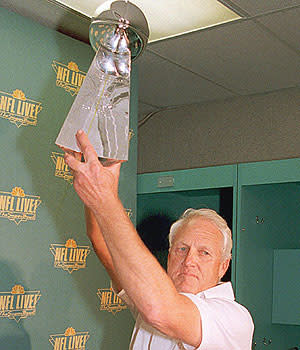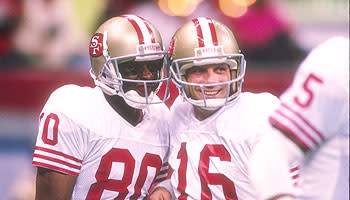The ultimate architect
"No aspect of coaching is more important than teaching." – Bill Walsh: Finding the Winning Edge
Let the record reflect that Bill Walsh's final lesson as an NFL head coach didn't end until the clock had spun dry.
Find a tape of Super Bowl XXIII. With 34 seconds left in the game, find the coach in the white polo shirt on the San Francisco 49ers sideline. He's the one wearing the headset, emotionless in a sea of joy and screams and pumping fists. Seconds after John Taylor had scored the 49ers' go-ahead touchdown in an eventual 20-16 win over the Cincinnati Bengals, San Francisco's sideline locked into a singular embrace. 49ers owner Eddie DeBartolo furiously was hugging anyone and everyone. Assistant coaches were flying into the arms of one another.
In the middle of it all was Walsh, who passed away Monday after a lengthy battle with leukemia. While others celebrate, he can be seen swimming upstream through triumphant chaos, heading to deliver one last lesson to his defensive players.
|
"Even when Taylor scores and they ostensibly are going to win the game, and Bill's career as an NFL head coach – known only to Bill – is basically over, there wasn't jubilation or jumping for joy or the high-fiving that most of us coaches would have done," said Baltimore Ravens coach Brian Billick, who spent two years with Walsh as a public relations assistant and later co-wrote a book with him. "Bill immediately turned around and got back into focus and continued to coach. That discipline and focus he had was instantaneous."
Of course, Walsh's calmness and composure in the waning seconds were overshadowed by the exploits of his offense. If you want to know why Walsh's teachings have shaped the NFL landscape almost 18 years later, why his West Coast offense has become a cornerstone in the league, find that tape. Watch the final 3:20 of the fourth quarter. It's a championship dissertation on the success of his system and the future of his coaching pupils.
"That last drive is consummate Bill Walsh," Billick said. "All the attention to detail and countless repetitions led to them executing it the way they did in that Super Bowl. Even the plays that were called – the angles, the Texas route to Roger Craig, the skinny post to John Taylor – those were all vintage Bill Walsh."
Almost two decades after that final drive, Walsh's system has become an integral part of the NFL's offensive landscape, so much so that it's hard to decipher which teams truly are running a West Coast offense. The scheme has been tweaked and bent and morphed to the point where you could say half the teams in the league are employing some modified version. What's clear is that everyone leans on it somewhere in its playbook, making Walsh's system arguably the most influential ideology since the introduction of the Wing-T formation.
"There are so many offshoots of it, it's amazing," said Seattle Seahawks defensive coordinator John Marshall, who works for Walsh disciple Mike Holmgren and faced the 49ers twice a year in the 1980s as the defensive coordinator of the Atlanta Falcons. "Even now, parts of the West Coast offense have been put into other schemes that aren't necessarily West Coast by nature."
Marshall remembers a time when he only had to prepare for Walsh's system twice a season within the division. But when he breaks down film of opponents these days, he sees something funny. What once seemed like a fad has become a staple. Marshall looks at NFL offenses today, and he sees unmistakable fingerprints.
And they belong to Bill Walsh.
BUILDING BLOCKS
Like the roots of a tree, it has become difficult to decipher where the West Coast system begins and ends from team to team. But that's not the case historically. Walsh never shied away from revealing the DNA of his scheme, which traces its lineage to Sid Gillman during his AFL days with the Los Angeles/San Diego Chargers.
In reality, there are two styles of the West Coast offense – both modified extensions of what Gillman was doing in the 1960s. The more vertical version, fit for big-armed passers, is associated with Don Coryell's "Air Coryell" system employed with the St. Louis Cardinals and Chargers in the '70s. The more horizontal, timing-precise system, suitable for quarterbacks with moderate arm strength, was developed by Walsh when he was an assistant with the Bengals.
Walsh began as a student of the vertical system until he was saddled with the average arm of Virgil Carter. It was Carter's lacking deep ball that prompted Walsh to take Gillman's wide-open passing tactics and modify them. Rather than consistently going downfield with the football, which didn't fit Carter's strengths, Walsh constructed a system of intermediate passing plays that would tug a defense's seams horizontally.
"To me, the West Coast offense is a euphemism for the Walshian offense. I don't know why we label it something it's not," Billick said. "Of course, I'm sure the people in Ohio like to think it's the Western Ohio offense from the Cincinnati days. And Bill was always the first one to give credit to much of what he believed is extended from Sid Gillman and Paul Brown."
|
The ideology was polished in the '80s with San Francisco to the point where the system overshadows many of Walsh's other attributes. Hired from Stanford in 1979 and given the authority to build from the ground up by DeBartolo, Walsh showcased a curator's eye for talent. By his first Super Bowl win after the 1981 season, he'd rebuilt the entire 49ers secondary with the likes of Eric Wright, Carlton Williamson and Dwight Hicks, and added other future Pro Bowlers like linebacker Keena Turner and defensive tackle Fred Dean.
In an environment Walsh often likened to Camelot, he became the coach who nabbed the best defensive talent he could find, then drafted offensive players who fit his style. His linemen often were smaller and more mobile. His running backs were versatile. His tight ends were deep and interchangeable. His wideouts ran routes with absolute precision. And his coaching staff was expected to know his system well enough to teach it – not just recite it.
"The key to that system is attention to detail," Billick said. "How you install it, how precise you are when you practice it during the course of the week, and the meticulous detail you put into it for when and where you want to call it. If you watched Bill install that infamous (play) '22-Z-In' the first time, and then saw him do it the 1,000th time, it was with the same meticulous professorial attention to detail."
SIMPLIFIED APPROACH
Before Walsh refined his own West Coast system, passing offenses largely were predicated on quarterbacks dropping deep into the pocket and going through reads as receivers came open in front of them. But Walsh's system was based more on exact timing – not waiting for routes to fully develop. While conventional passing relied on wideouts working themselves open against coverage, Walsh's system relied more on rhythm – throwing to a predetermined open spot at a certain moment and depending on a wideout to be there at that exact time.
The open spot depended largely on the defense, with the quarterback and his receivers or running backs adjusting their routes based on what was presented by defenders. In a way, it was like a dance. Much the way a ballroom dancer knows his steps when he hears the melody of a fox trot, tango or waltz, players in a West Coast system know their steps when they see what a defense is doing before the snap. In essence, the West Coast offense has an answer – a specific set of footwork, timing and direction – for everything a defense offers. And every offensive player is expected to know what the answer is based on the defensive front presented.
One of the staple plays that survived the test of time and showcased timing is the quick slant, which depends on a three-step drop-and-fire from the quarterback and essentially is a running play by executed by a wideout. Another is the 22-Z-In, in which the primary target is an intermediate route by the flanker designed for a 12-yard gain.
|
"It really simplified the game," Rice said. "There's nothing worse when you call a play in the huddle and you come to the line of scrimmage, and they're not in the defense you thought they would be in. That's why with the West Coast offense you had so many adjustments. There was always something that you could go to. Joe (Montana), he knew the system well. He knew where his primary would be, where his secondary receiver would be and where his third receiver would be, just by looking at the defense.
"Say I come to the line of scrimmage and I had a 12-yard hook route called for me. But all of the sudden, I don't have the defense I want. Instead of the cornerback playing off where I can make that hook route, I have him right there on me. So my adjustment is playing bump and run and going for a speed move downfield."
Rice stopped and chuckled in contemplation.
"Man," he said, "I wanted that offense to last forever."
HIS LEGACY
With Walsh's passing, the legacy will be split in two. Part of it resides in the halls of the 49ers organization, in pictures and trophies and stories of greatness that continue to reverberate through the city. The second part will be carried in the minds of all the coaches he sent forth into the NFL, who carried his system with them, eventually passing it on to their own coaching tree. From Walsh to Holmgren to Andy Reid to Brad Childress. Amazingly, eight of the last 18 Super Bowl champions were guided by head coaches who have a connection to Walsh's tree. And most of those coaches have gone on to develop their own trees as well.
"When I think of Bill, that's what I think of – his Super Bowl championships, the great 49er teams that they had, and the popularization of that system through his assistants," said New England Patriots coach Bill Belichick. "Similar to Paul Brown, Bill had so many coaches go on – maybe all of them didn't work for Bill, but they worked and learned from someone Bill coached. That's awfully remarkable."
Added Billick, "We all try to help the people we work with, and sometimes it's nothing more than lip service. But I've never seen a coach that was more tireless in his efforts to teach and help coaches advance. That is one thing even critics of Bill Walsh have to admire."
And in a way, Walsh lives on in all the coaches, all the players and all their achievements that will stretch on for years to come. Nobody forgets Camelot. Or the King that built it.
"He was everything," Rice said. "He was the coach. He was the parent. He was the mentor. He was just like a father to me. And when I look back over my career, I know it was all about Bill Walsh."






